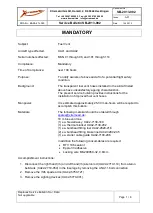
16
11. Cycle your receiver battery pack (if necessary) and
make sure it is fully charged.
12. If you wish to photograph your model, do so before
your first flight.
13. Range check your radio when you get to the
flying field.
FLYING
MOUNT THE wING
Mount the wing to the fuselage with included eight #64 rubber
bands. Install them from front to back, crisscrossing the last
two. Never use torn or cracked rubber bands. After removing
the rubber bands from your model, store them in a container
with talcum powder or clay-type kitty litter to keep them fresh
for the next flying session.
If the rubber bands you will be using are different from those
recommended, consult an experienced modeler to make
certain they are strong enough, and that you have used
enough of them. If uncertain, force the front of the wing off of
the wing saddle. There should be considerable resistance!
If the wing can be forced from the fuselage without having
to strain your hands, then there are probably not enough
rubber bands.
IMPORTANT: Flying a model with too few rubber
bands can be dangerous. If the wing momentarily lifts
from the fuselage and acts as though a large amount of
“up” elevator has suddenly been applied because there
are not enough rubber bands or they are too weak,
internal structural damage may result. Even worse, the
wing could actually detach from the fuselage resulting in
a crash. If the model exhibits any tendencies that indicate
there are not enough rubber bands, immediately land
and closely inspect the model for damage. If no damage
is found, add more rubber bands.
If you are flying with other flyers check to make sure they are
not flying or testing on the same frequency as your model.
If you are an inexperienced pilot try to find an experienced
pilot to help you with your first flights. Although the
Sophisticated Lady is very easy to fly, an experienced pilot
can save you a lot of time and possible aggravation by
helping you get your model in the air smoothly.
CAUTION (THIS APPLIES TO ALL R/C AIRPLANES):
If, while flying, you notice an alarming or unusual sound
such as a low-pitched “buzz,” this may indicate control
surface
flutter.
Flutter occurs when a control surface
(such as an aileron or elevator) or a flying surface
(such as a wing or stab) rapidly vibrates up and down
(thus causing the noise). In extreme cases, if not
detected immediately, flutter can actually cause the
control surface to detach or the flying surface to fail,
thus causing loss of control followed by an impending
crash. The best thing to do when flutter is detected is
to slow the model
immediately, then land as soon as
safely possible. Identify which surface fluttered (so the
problem may be resolved) by checking all the servo
grommets for deterioration or signs of vibration. Make
certain all pushrod linkages are secure and free of
play. If it fluttered once, under similar circumstances it
will probably flutter again unless the problem is fixed.
Some things which can cause flutter are; Excessive
hinge gap; Not mounting control horns solidly; Poor fit
of clevis pin in horn; Side-play of wire pushrods caused
by large bends; Excessive free play in servo gears;
Insecure servo mounting.
TRIM FLIGHTS
It is a good idea to do a couple of trim flights before each flying
session to make sure the plane is still in trim and the radio is
working properly. The model will survive a hard landing from
5 feet much better than it will from several hundred feet. The
first few trim flights should be done over a grass field, the
longer the grass the better (more cushion). If possible, have
a friend hand launch the sailplane the first few trim flights.
This will allow you more time to make adjustments.
Switch the transmitter on first and then the receiver. Hold
the Sophisticated Lady ARF under the wing with the nose
pointed slightly down and directly into the wind. It is very
important that it be launched with the wings level and the
nose pointed at a spot on the ground about 50 feet [15.2m]
in front of you. If the sailplane is launched with the nose up or
launched too hard, it will climb a few feet, stall and fall nose
first straight down. With the nose pointed down slightly the
sailplane will accelerate down until it picks up enough flying
speed then level off and glide forward. With a little practice
you will be able to launch it at just the right speed so it soars
straight ahead in a long and impressive glide path. Adjust the
trims on your transmitter to get the plane to fly straight ahead
in a smooth glide path.
Once you get the hang of launching it you can try turning the
plane during the trim flights by gently applying a “touch” of
right or left rudder. You can also try “flaring” the landing by
slowly applying a touch of up elevator (pull the stick back)
as the plane nears the ground. The Sophisticated Lady ARF
will continue to fly just a few inches off of the ground for
a surprisingly long distance. It is important you don’t “over
control” the model. Make any control inputs slowly and
smoothly rather than moving the transmitter sticks abruptly.





































